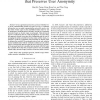5511 search results - page 927 / 1103 » Security for Network Places |
ACSAC
2009
IEEE
14 years 4 months ago
2009
IEEE
To protect privacy in large systems, users must be able to authenticate against a central server without disclosing their identity to the network. Private identification protocols ...
ACSAC
2009
IEEE
14 years 4 months ago
2009
IEEE
—The amount of dynamic content on the web has been steadily increasing. Scripting languages such as JavaScript and browser extensions such as Adobe’s Flash have been instrument...
ESORICS
2009
Springer
14 years 4 months ago
2009
Springer
Abstract. Covert timing channels aim at transmitting hidden messages by controlling the time between transmissions of consecutive payload packets in overt network communication. Pr...
ICC
2009
IEEE
14 years 4 months ago
2009
IEEE
—A key agreement protocol is a protocol whereby two or more communicating parties can agree on a key or exchange information over an open communication network in such a way that...
SACRYPT
2009
Springer
14 years 4 months ago
2009
Springer
Format-preserving encryption (FPE) encrypts a plaintext of some specified format into a ciphertext of identical format—for example, encrypting a valid credit-card number into a ...


